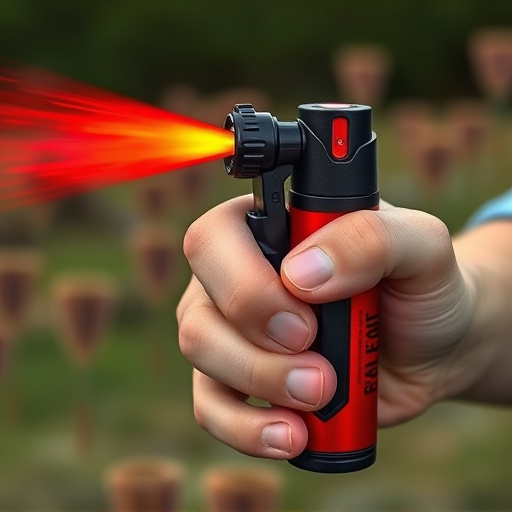In riot control situations, understanding wind direction is key for effective pepper spray deployment. Aiming into the wind allows precise targeting of sensitive areas like the face and eyes, maximizing impact. Conversely, spraying against the wind can lead to unpredictable results, causing harm to bystanders or complicating crowd control. Best practices include assessing wind patterns, following up with a second burst, maintaining safe distances, regular equipment maintenance, clear communication, and decontamination protocols to ensure strategic, safe, and responsible use of pepper spray canisters, prioritizing both effectiveness and safety.
“Uncover the power dynamics of riot control with a deep dive into pepper spray canisters – a pivotal tool in law enforcement. This comprehensive guide explores ‘Understanding Pepper Spray Canisters’ from mechanism to effectiveness, delving into key considerations like wind direction, crucial for strategic deployment. We provide practical tips on usage and safety, ensuring best practices for officers while navigating challenging situations. Discover how wind patterns influence spray dispersion, empowering you with valuable insights for tactical decision-making and effective riot control.”
- Understanding Pepper Spray Canisters: A Comprehensive Overview
- The Role of Wind Direction in Riot Control
- Effective Usage Strategies and Tips for Pepper Spray
- Safety Considerations and Best Practices for Law Enforcement
Understanding Pepper Spray Canisters: A Comprehensive Overview
Pepper spray canisters are powerful tools used for riot control and self-defense, emitting a pungent chemical that temporarily incapacitates individuals. These devices operate on the principle of delivering capsaicin, the active ingredient found in chili peppers, which irritates the eyes, nose, throat, and skin. Understanding pepper spray’s mechanism is crucial when it comes to effective deployment, especially considering key factors like wind direction.
When using a pepper spray canister, the wind direction tips play a significant role in its effectiveness. It’s recommended to aim for the face and eyes of the target, as these areas are most sensitive to capsaicin. However, if the wind is blowing towards you or the target, it can carry the spray back, potentially affecting your own respiratory system or reducing the canister’s impact. Therefore, knowing and accounting for wind direction is essential for both safety and optimal results when utilizing pepper spray during riot control situations.
The Role of Wind Direction in Riot Control
In riot control situations, understanding the wind direction is a strategic tip for deploying pepper spray effectively. The flow of air plays a crucial role in how the canister’s contents disperse and can significantly impact the outcome of crowd control efforts. When using pepper spray, aiming into the wind allows for a more precise and targeted application, ensuring that the agents reach the intended individuals directly. This tactic is especially useful when dealing with crowds where specific areas need to be temporarily neutralized or when officers want to contain the spread of irritants.
Conversely, spraying against the wind can lead to unpredictable results as the spray may bounce back or linger in the air, potentially causing harm to bystanders or making it harder to control the crowd. Pepper spray is designed to create a temporary but intense irritation, and proper wind management enhances its effectiveness while minimizing risks. Officers trained in riot control tactics often consider wind direction as a key variable when deciding when and how to deploy these tools, ensuring safety and efficiency during chaotic events.
Effective Usage Strategies and Tips for Pepper Spray
When utilizing pepper spray, understanding the wind direction is crucial for its effective usage. Aiming into the wind ensures the irritant reaches its target, providing maximum impact and range. Conversely, spraying against the wind risks blowing the solution back towards the user, defeating the purpose. Therefore, assessing and predicting wind patterns before deployment is a strategic tip worth emphasizing.
To maximize pepper spray’s effectiveness, users should consider a few additional tips. First, aim for the face and eyes as these areas are highly sensitive. Second, follow up with a second burst after the initial application, allowing time for the first dose to take effect. Lastly, practice in controlled environments to familiarize yourself with its range and impact, ensuring safe and responsible use.
Safety Considerations and Best Practices for Law Enforcement
When deploying riot control inflammatory spray canisters, law enforcement must prioritize safety and adhere to best practices. Understanding pepper spray dynamics, particularly its wind direction, is paramount for effective and safe use. Pepper spray acts by irritating the eyes and respiratory system, so knowing how wind affects its dispersion is crucial. Typically, spraying downwind reduces the risk of backblowing, where the spray returns to the user or nearby civilians. However, upwind deployment can be strategic in confined spaces or when targeting specific individuals.
Best practices include ensuring adequate training on pepper spray application and de-escalation techniques. Officers should maintain a safe distance from bystanders and use the lowest effective concentration necessary. Regular maintenance of equipment and clear communication with colleagues about spray usage are also essential to mitigate risks. Additionally, having protocols in place for decontaminating after use ensures the safety of both officers and the community.
In conclusion, pepper spray canisters are a critical tool in riot control, with their effectiveness significantly influenced by wind direction. Understanding how to utilize these devices effectively and safely is paramount for law enforcement. By employing the right usage strategies and staying informed about safety considerations, including wind patterns, officers can ensure the optimal deployment of pepper spray during chaotic situations, ultimately helping to de-escalate tensions and maintain public safety.
